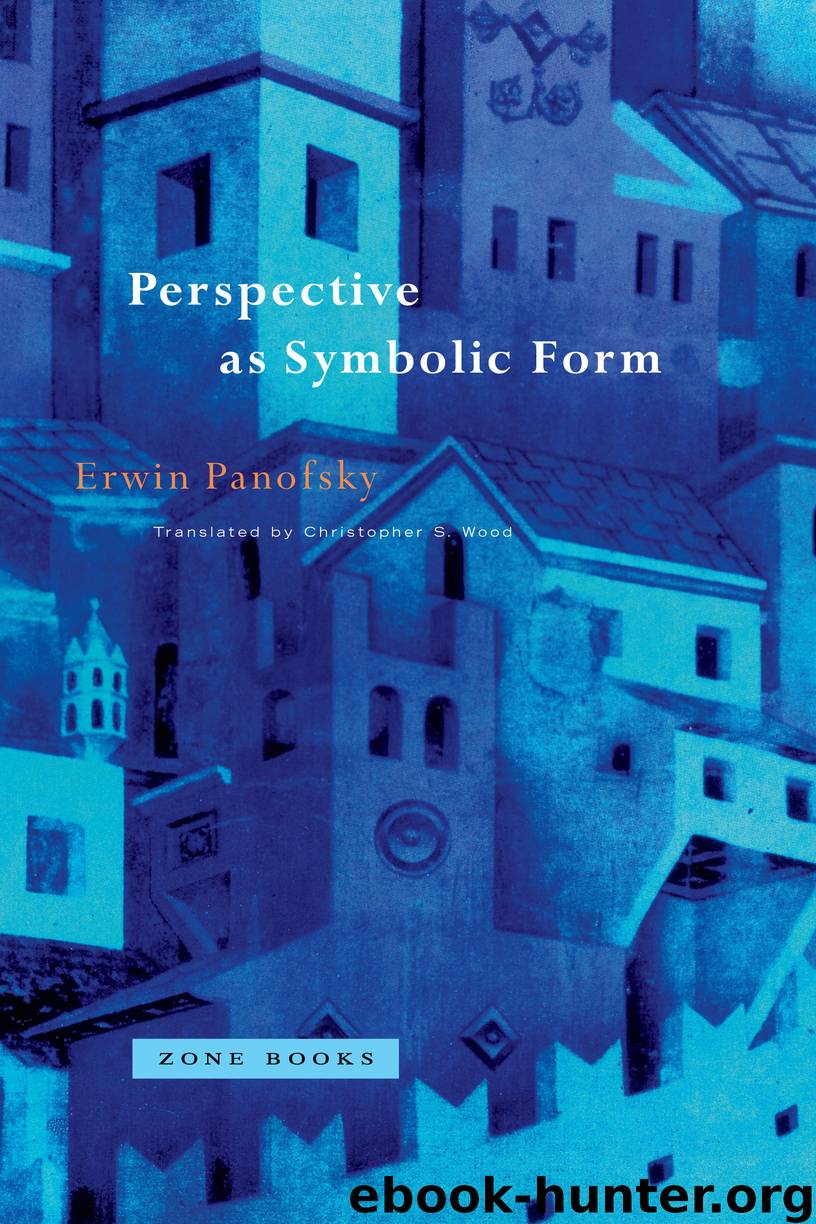Perspective as Symbolic Form by Erwin Panofsky

Author:Erwin Panofsky
Language: eng
Format: epub, pdf
Publisher: Zone Books
Published: 2020-07-29T16:00:00+00:00
As complicated and, as it were, acrobatic this explanation appears, it nevertheless looks like the most plausible, albeit only under the assumption of an almost unimaginably sensitive and elastic sense of form. It is perhaps even corroborated, even if only indirectly, by the passage just quoted from Geminos about towers. If it says there that towers seen from afar seem to “fall forward,” then it follows that antique consciousness must in fact have been accustomed to carrying out a kind of overcompensation in Giovannoni’s sense. For in and of itself perspectival foreshortening of vertical structures, when it is very strong (for example at close range), produces the impression of falling backward; thus Vitruvius’s precept about the inclining of cornices (3.5.13). And when the foreshortening is weak (for example at long range), and when therefore a normal impression of objective verticality might justifiably be expected, then the illusion of falling forward can only be the effect of overcompensation.
It should, however, not be concealed that those very curvatures of the temple of Hercules at Cori upon which Giovannoni built his theory have recently turned out to be merely accidental: see the apparently conclusive presentation by Armin von Gerkan, “Die Krümmungen im.Gebälk des dorischen Tempels in Cori,” Mitteilungen des Deutschen Archäologischen Instituts, Römische Abteilung 40 (1925), pp. 167–80.
It is most interesting that antique theory, when it asserts that an angle appears rounded when seen from afar, finds itself in accord with the most recent psychological research: H. Werner has proven that the less one conceives of an angular structure as “articulated,” that is, the more one perceives the “angle” as the mere interruption of a single form and not as the encounter of two forms, then the more the structure undergoes a kind of polishing off or rounding (“Studien über Strukturgesetze,” Zeitschrift für Psychologie 94 [1924], p. 248ff.). This phenomenon appears, for example, when a broken line is drawn over and over again by an experimental subject instructed to maintain an “integral” perception; but also when unclear vision – for example at a great distance – hinders the “articulated” and favors the “integral” perception. If, on the contrary, the subject is held to the “articulated” perception, then there emerges an increasing tendency toward a concave sharpening of the corner. This would be the case at Segesta, where the tapering off of the facade preserves the clear “articulation” of the building from the rounding off that would otherwise threaten when seen from a distance.
This also sheds light on a curious phenomenon in medieval miniatures (the best-known examples are the Reichenauer manuscripts in Munich, Bayerische Staatsbibliothek, Cim. 57, 58, 59, published by Georg Leidinger in the series Miniaturen aus Handschriften der Kgl. Hof- und Staatsbibliothek in München), namely, when the prismatic crib in which the Christ child lies (or towers or other such objects) is represented in the form of Figure 12A. This peculiar rounding off of the rear corner is evidently explained by the failure of the medieval artists to understand the perspectivally foreshortened forms of their (presumably early Christian) models.
Download
Perspective as Symbolic Form by Erwin Panofsky.pdf
This site does not store any files on its server. We only index and link to content provided by other sites. Please contact the content providers to delete copyright contents if any and email us, we'll remove relevant links or contents immediately.
Papillon by Henry Charrière(796)
Watercolor With Me in the Forest by Dana Fox(589)
The Story of the Scrolls by The Story of the Scrolls; the M(556)
This Is Modern Art by Kevin Coval(458)
A Theory of Narrative Drawing by Simon Grennan(455)
Frida Kahlo by Frida Kahlo & Hayden Herrera(445)
Boris Johnson by Tom Bower(442)
Banksy by Will Ellsworth-Jones(434)
AP Art History by John B. Nici(428)
Van Gogh by Gregory White Smith(425)
The Art and Science of Drawing by Brent Eviston(423)
Draw More Furries by Jared Hodges(422)
Glittering Images: A Journey Through Art From Egypt to Star Wars by Camille Paglia(417)
War Paint by Woodhead Lindy(413)
Scenes From a Revolution by Mark Harris(412)
100 Greatest Country Artists by Hal Leonard Corp(391)
Ecstasy by Eisner.;(386)
Young Rembrandt: A Biography by Onno Blom(373)
Theater by Rene Girard(354)
